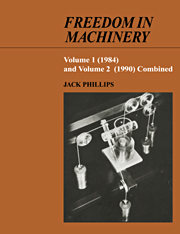Book contents
- Frontmatter
- Dedication
- Contents
- Preface
- General introduction
- 1 Mechanism and the mobility of mechanism
- 2 Overconstraint and the nature of mechanical motion
- 3 Some of the various lines in a moving body
- 4 Enumerative geometry and the powers of infinity
- 5 Rigidity and the instantaneous screw axis
- 6 Irregularity and the freedoms within a joint
- 7 The possibilities in reality for practical joints
- 8 Some elementary aspects of two degrees of freedom
- 9 The linear complex of right lines in a moving body
- 10 Line systems and the dual vectors in mechanics
- 11 Geometrical properties of the linear line systems
- 12 The vector polygons for spatial mechanism
- 13 On the two theorems of three axes
- 14 Some reciprocities across the middle number three
- 15 The generality and the geometry of the cylindroid
- 16 The discovery in a mechanism of a cylindroid
- 17 Action, notion, clearances and backlash
- 18 Singular events in the cycles of motion
- 19 Fundamental relations and some algebraic methods
- 20 The special geometry of some overconstrained loops
- 21 The helitangent lines in a moving body
- 22 The cylindroid in gear technology
- 23 The general and the special screw systems
- Bibliography
- Index of proper names
- Subject Index
10 - Line systems and the dual vectors in mechanics
Published online by Cambridge University Press: 07 September 2010
- Frontmatter
- Dedication
- Contents
- Preface
- General introduction
- 1 Mechanism and the mobility of mechanism
- 2 Overconstraint and the nature of mechanical motion
- 3 Some of the various lines in a moving body
- 4 Enumerative geometry and the powers of infinity
- 5 Rigidity and the instantaneous screw axis
- 6 Irregularity and the freedoms within a joint
- 7 The possibilities in reality for practical joints
- 8 Some elementary aspects of two degrees of freedom
- 9 The linear complex of right lines in a moving body
- 10 Line systems and the dual vectors in mechanics
- 11 Geometrical properties of the linear line systems
- 12 The vector polygons for spatial mechanism
- 13 On the two theorems of three axes
- 14 Some reciprocities across the middle number three
- 15 The generality and the geometry of the cylindroid
- 16 The discovery in a mechanism of a cylindroid
- 17 Action, notion, clearances and backlash
- 18 Singular events in the cycles of motion
- 19 Fundamental relations and some algebraic methods
- 20 The special geometry of some overconstrained loops
- 21 The helitangent lines in a moving body
- 22 The cylindroid in gear technology
- 23 The general and the special screw systems
- Bibliography
- Index of proper names
- Subject Index
Summary
Opening remarks
01. In chapter 6 and in other parts of this book hitherto I have spoken about systems of ISAs or of screws, or more simply about screw systems. The origin in physical reality for most of these spoken remarks about screws was the capacity for instantaneous motion of some rigid body whose freedom to move at the instant was being restricted in some way. Relationships exist between these systems of screws about which small twists or rates of twisting of one body relative to another may occur, namely the systems of ISAs, and identical kinds of systems of screws about which wrenches and reaction wrenches between the same two bodies may act. An investigation of these two sets of systems of screws will reveal, at the end of this chapter 10, (a) an insight into the power expended in friction at working joints in mechanism, (b) an amplified meaning for the somewhat narrow term joint as defined for example at § 1.11, and (c) the beginnings of a method for calculating the forces at work at the joints of mechanism where mass and the consequent inertia of links is an important consideration.
02. With regard to (b) above I can mean by joint, as I shall show, the joint between for example the piston and the connecting rod of an engine designed for the transmission of power in the absence of loss, or the joint between for example a bulldozer blade and its one-off job where power is being releases in spurts, or the joint between a ploughing tool and its sod which is in a continuous, power-releasing action.
- Type
- Chapter
- Information
- Freedom in Machinery , pp. 152 - 172Publisher: Cambridge University PressPrint publication year: 2007

